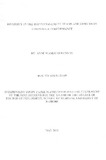| dc.description.abstract | The globalization process has dramatically changed the business landscape and the society in which
we live. This has affected all the business organizations. As the environment becomes more complex,
firms seeking to gain competitive advantage over other firms in their environment should attempt to
become more innovative and proactive (Brittain and Freeman, 1980). Firms should increase
experimental behaviour to find novel answers where old ones no longer work (Dutton and Freedman,
1985). Managing with uncertainties is among the most difficult tasks executives face .The challenges
faced by top managers is to process many, complex, and often ambiguous stimuli when making
strategic decisions under high uncertainty(Starbuck & Milliken, 1988). This is precisely the reason why
the strategist must pay close attention the top management. The notion that the characteristics of
senior management, or the upper echelon of an organization, can influence the decisions made and
practices adopted by an organization dates back to early upper echelon theory (Hambrick & Mason,
1984). Hambrick and Mason argued that managers’ characteristics (demographic) influence the
decisions that they make and therefore the actions adopted by the organizations that they lead. They
suggest that this occurs because demographic characteristics are associated with the many cognitive
bases, values, and perceptions that influence the decision making of managers. Admittedly, to a large
extent, diversity enhances greater creativity, innovativeness and quality decision making and could
create greater competitiveness (Hambrick et. al., 1996). This paper explores empirical literature and
gives conceptual overview that will have its unique contribution on exploring the scope of diversity in
the top management, as well as widening the application of the upper echelon theory and the
implications on firm performance. It will further help organizations in identifying what characteristics
they need to identify in a person who is to take a top management job. | en |

